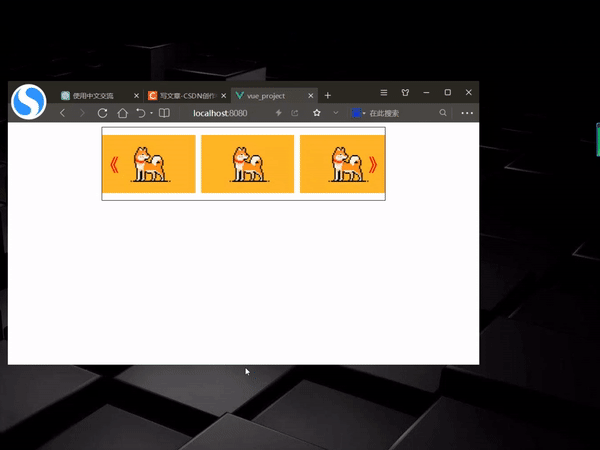写了个适应性比较强的Vue的组件,有需要的可以直接取用。
点个关注,给你带来更多花里胡哨的组件与代码∠( ᐛ 」∠)_
先看效果:

自动轮播、悬停放大、按键控制,看起来似乎没什么特比的,接下来我就讲一讲这个组件设计上的独特之处。
首先是大小的自适应,该组件会根据引用处父组件的位置调整自身大小,
也就是说无论父组件大小如何,该组件总能以相对正常的形式显示。

甚至连箭头的相对位置都没有改变。
其次,该组件可以适应任何大小的图片,即使图片大小并不统一也同样可以实现逐张滚动。

接下来说说实现思路。
1. 首先,在 data 中定义了 `photoList` 数组,用于存储要轮播的图片路径,以及 `currentIndex` 表示当前显示图片的索引。
data() {
return {
photoList: [photo, photo2, photo, photo, photo2, photo2, photo],
currentIndex: 0,
time: null,
};
},2. 在 `mounted` 钩子中,设置一个定时器 `this.time`,每隔 3 秒触发一次 `moveRight` 方法,使得图片自动向右轮播。
mounted() {
this.time = setInterval(() => {
if (this.currentIndex < photo.length) {
this.moveRight();
}
}, 3000);
},3. `moveLeft` 和 `moveRight` 方法用于切换图片的索引,使得图片向左或向右滚动。
moveLeft() {
if (this.currentIndex > 0) {
this.currentIndex = this.currentIndex - 1;
}
},
moveRight() {
if (this.currentIndex < this.photoList.length - 1) {
this.currentIndex = this.currentIndex + 1;
}
},4. `stopScroll` 方法用于清除定时器 `this.time`,当鼠标移入轮播容器时,停止图片的自动滚动。
5. `startScroll` 方法用于重新启动定时器 `this.time`,当鼠标移出轮播容器时,继续图片的自动滚动。
//鼠标移入停止滚动
stopScroll() {
clearInterval(this.time);
console.log("停止滚动");
},
//鼠标移出继续滚动
startScroll() {
this.time = setInterval(() => {
if (this.currentIndex < photo.length) {
this.moveRight();
}
}, 3000);
console.log("继续滚动");
},6. 使用 `@mouseenter` 和 `@mouseleave` 事件监听鼠标进入和移出事件,分别调用 `stopScroll` 和 `startScroll` 方法,实现图片在鼠标悬停时停止滚动,在鼠标移出时继续滚动。
<template>
<div class="room" @mouseenter="stopScroll" @mouseleave="startScroll">
<div class="back">
<img v-for="(item, index) in photoList" :key="index" :src="item" />
</div>
<span class="left" @click="moveLeft">《</span>
<span class="right" @click="moveRight">》</span>
</div>
</template>7. 使用 `watch` 监听 `currentIndex` 的变化,在图片切换时更新 `.back` 元素的 `transform` 样式,使得图片容器向左滚动,从而展示当前图片,由于偏移量是直接读取了子元素相对容器左侧的距离,所以即使图片宽度不同每次也都能正常轮播。
watch: {
currentIndex(newValue) {
const parentElement = document.querySelector(".back");
const childrenElement = parentElement.children;
parentElement.style.transform =
"translateX(" + -childrenElement[newValue].offsetLeft + "px)";
},
},8. 在样式中,设置 `.room` 容器为相对定位,限制其内容的显示范围;设置 `.back` 容器为绝对定位,用于容纳图片并实现水平滚动效果;设置 `.left` 和 `.right` 元素为绝对定位,分别表示左右箭头,用于点击切换图片。同时使用 `transition` 实现图片切换的动画效果。
附完整代码,使用时记得修改图片路径:
<template>
<div class="room" @mouseenter="stopScroll" @mouseleave="startScroll">
<div class="back">
<img v-for="(item, index) in photoList" :key="index" :src="item" />
</div>
<span class="left" @click="moveLeft">《</span>
<span class="right" @click="moveRight">》</span>
</div>
</template>
<script>
import photo from "../../image/02.jpg";
import photo2 from "../../image/02 - 副本.jpg";
export default {
data() {
return {
photoList: [photo, photo2, photo, photo, photo2, photo2, photo],
currentIndex: 0,
time: null,
};
},
methods: {
moveLeft() {
if (this.currentIndex > 0) {
this.currentIndex = this.currentIndex - 1;
}
},
moveRight() {
if (this.currentIndex < this.photoList.length - 1) {
this.currentIndex = this.currentIndex + 1;
}
},
stopScroll() {
clearInterval(this.time);
console.log("停止滚动");
},
//鼠标移出继续滚动
startScroll() {
this.time = setInterval(() => {
if (this.currentIndex < photo.length) {
this.moveRight();
}
}, 3000);
console.log("继续滚动");
},
},
mounted() {
this.time = setInterval(() => {
if (this.currentIndex < photo.length) {
this.moveRight();
}
}, 3000);
},
watch: {
currentIndex(newValue) {
const parentElement = document.querySelector(".back");
const childrenElement = parentElement.children;
parentElement.style.transform =
"translateX(" + -childrenElement[newValue].offsetLeft + "px)";
},
},
};
</script>
<style scoped>
.room {
width: 100%;
height: 100%;
overflow: hidden;
position: relative;
}
.back {
height: 100%;
display: flex;
align-items: center;
flex-wrap: nowrap;
transition: 0.5s;
}
.back img {
height: 80%;
margin: 0 1%;
transition: 0.5s;
}
.back img:hover {
height: 100%;
margin: 0 0;
}
.room span {
position: absolute;
top: 50%;
color: red;
font-size: 30px;
font-weight: 700;
transform: translateY(-50%);
cursor: pointer;
}
.left {
left: 0%;
}
.right {
right: 0%;
}
</style>